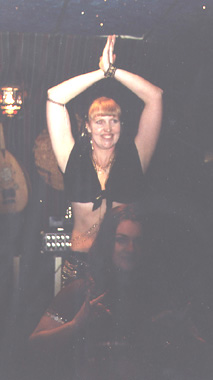 |
| Meg Green with April Helmer in foreground at their November 2000 hafla debut at the Aladdin Restaurant, Allentown, PA |
DANCE IS
CELEBRATION OF LIFE
By Meg Green
The Express-Times, Easton, Pennsylvania
Category: Features; Page: AA1
Published: 05/07/2000
If you're anything like my mother, you're wondering what in the world a nice American farm girl like me is doing in an Arabic dance class. It's just not practical to wear sequins, chiffon and finger cymbals. It's just not practical to trace the footsteps of ancient women from another culture. Not practical, perhaps, but it sure is fun.
About a year ago, I attended my first class in a room filled with sunlight and incense at the Riverview Arts Center in Phillipsburg. Tahya, our teacher, welcomed us with taped Arabic music, exotic melodies played by instruments I've never heard of: dumbek, riqq and oud. She wore a black unitard with a sarong around her hips, a scarf with coins that tinkled as she moved, and an exotic-looking headband that draped similar coins across her forehead. The rest of the class varied in age from teen to a possible grandmother, and everyone looked as if they might have just finished their laundry: T-shirts, pants, shorts and a few dresses. Not a belly was showing, and there was not a single sequin in sight.
Tahya started by explaining that belly dancing is an American nickname for an ancient dance. The name was launched by an enterprising public relations man at the World's Fair in late 1800s. He hired Egyptian dancers to perform wearing native costumes, including gauzy shirts and ornate vests. Victorian spectators were titillated to see the women's stomachs undulate as they spun and danced, and a misnomer was born.
Arabic dance, also called Danse Orientale,
dates back thousands of years to a time
when people used rituals to mark the turning of the seasons
and the dance of stars and moon.
It's also alive today at Arabic weddings and festivals.
We circle right, then left, then try to trace
a figure eight - the symbol for infinity - parallel to the floor.
Tahya does it smoothly and looks beautiful...
As Tahya explains the basic hip lift and the basic hip circle, we focus just on our hips, without moving our feet. We circle right, then left, then try to trace a figure eight - the symbol for infinity - parallel to the floor. Tahya does it smoothly and looks beautiful. I feel like I'm trying to wiggle into too tight jeans, or get out of a wet bathing suit.
While she moves her hips, Tahya's arms float like long hair in a stream: fluid, graceful, sensuous. My arms feel too long ever to move that gracefully. A glance at my fellow students confirms my suspicion; we look like newly reformed smokers, unsure of what to do with our hands.
Still, we smile, and with practice, the movements became more fluid. You could say the circles and infinity symbols that we paint in the air with our bodies represent the never-ending cycle of life and death. But it's also a reflection of the sinuous music and intricate rhythms to which we dance.
We learn to walk like priestesses circling an ancient campfire before a moonlit ritual.
We learn to move as dancers...
With heads held high, we learn to gaze languidly
and enjoy the simple act of movement...
We learn to move as dancers, forgoing the hyper-fastwalk too common in our parking lot- and sidewalk-filled world. With heads held high, we learn to gaze languidly and enjoy the simple act of movement, without the need to rush past cubicles or grocery carts or cribs to do the million little chores that make up life.
Over time, we wear more flowing skirts and harem pants, and drape coin-scarves around our hips to accent our movements. With giant pieces of fabric called veils, we spin and twirl like children, and delight in how the fabric billows and drapes around us like sails.
Besides feeding my hidden passion for sequins and gold lame, Arabic dancing has given me more confidence. In a society that prizes super-thin models, I've become more comfortable in my "size large" skin. I walk a little taller now, even if I'm only headed to my tiny cubicle at work.
To me, the dance is both decadent and sacred. It's a time to put aside chores to look beautiful and sensuous, to create poetry with music and movement. Our dance is a celebration of life.
* * *
Meg Green is a former Express-Times staff writer who lives in Easton.
Meg's husband also wrote a lovely tale ...
of his "conversion"
CLICK HERE to read what he had to say
|